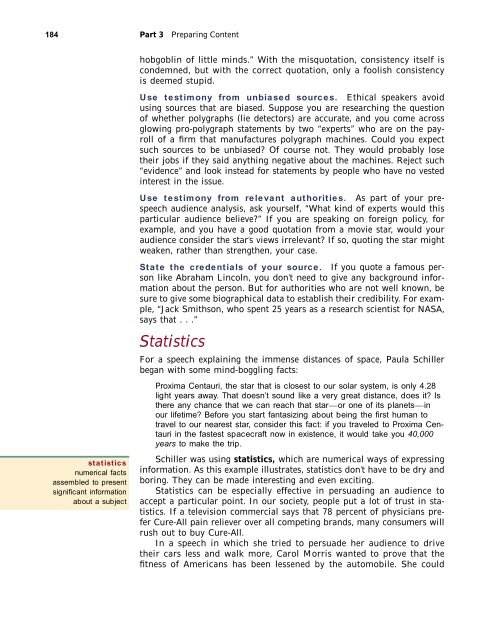Nurul Izzah Anwar, an engineering major at a college in Malaysia ...
Nurul Izzah Anwar, an engineering major at a college in Malaysia ...
Nurul Izzah Anwar, an engineering major at a college in Malaysia ...
Create successful ePaper yourself
Turn your PDF publications into a flip-book with our unique Google optimized e-Paper software.
184 Part 3 Prepar<strong>in</strong>g Content<br />
st<strong>at</strong>istics<br />
numerical facts<br />
assembled to present<br />
signific<strong>an</strong>t <strong>in</strong>form<strong>at</strong>ion<br />
about a subject<br />
hobgobl<strong>in</strong> of little m<strong>in</strong>ds.” With the misquot<strong>at</strong>ion, consistency itself is<br />
condemned, but with the correct quot<strong>at</strong>ion, only a foolish consistency<br />
is deemed stupid.<br />
Use testimony from unbiased sources. Ethical speakers avoid<br />
us<strong>in</strong>g sources th<strong>at</strong> are biased. Suppose you are research<strong>in</strong>g the question<br />
of whether polygraphs (lie detectors) are accur<strong>at</strong>e, <strong>an</strong>d you come across<br />
glow<strong>in</strong>g pro-polygraph st<strong>at</strong>ements by two “experts” who are on the payroll<br />
of a firm th<strong>at</strong> m<strong>an</strong>ufactures polygraph mach<strong>in</strong>es. Could you expect<br />
such sources to be unbiased? Of course not. They would probably lose<br />
their jobs if they said <strong>an</strong>yth<strong>in</strong>g neg<strong>at</strong>ive about the mach<strong>in</strong>es. Reject such<br />
“evidence” <strong>an</strong>d look <strong>in</strong>stead for st<strong>at</strong>ements by people who have no vested<br />
<strong>in</strong>terest <strong>in</strong> the issue.<br />
Use testimony from relev<strong>an</strong>t authorities. As part of your prespeech<br />
audience <strong>an</strong>alysis, ask yourself, “Wh<strong>at</strong> k<strong>in</strong>d of experts would this<br />
particular audience believe?” If you are speak<strong>in</strong>g on foreign policy, for<br />
example, <strong>an</strong>d you have a good quot<strong>at</strong>ion from a movie star, would your<br />
audience consider the star’s views irrelev<strong>an</strong>t? If so, quot<strong>in</strong>g the star might<br />
weaken, r<strong>at</strong>her th<strong>an</strong> strengthen, your case.<br />
St<strong>at</strong>e the credentials of your source. If you quote a famous person<br />
like Abraham L<strong>in</strong>coln, you don’t need to give <strong>an</strong>y background <strong>in</strong>form<strong>at</strong>ion<br />
about the person. But for authorities who are not well known, be<br />
sure to give some biographical d<strong>at</strong>a to establish their credibility. For example,<br />
“Jack Smithson, who spent 25 years as a research scientist for NASA,<br />
says th<strong>at</strong> . . .”<br />
St<strong>at</strong>istics<br />
For a speech expla<strong>in</strong><strong>in</strong>g the immense dist<strong>an</strong>ces of space, Paula Schiller<br />
beg<strong>an</strong> with some m<strong>in</strong>d-boggl<strong>in</strong>g facts:<br />
Proxima Centauri, the star th<strong>at</strong> is closest to our solar system, is only 4.28<br />
light years away. Th<strong>at</strong> doesn’t sound like a very gre<strong>at</strong> dist<strong>an</strong>ce, does it? Is<br />
there <strong>an</strong>y ch<strong>an</strong>ce th<strong>at</strong> we c<strong>an</strong> reach th<strong>at</strong> star—or one of its pl<strong>an</strong>ets—<strong>in</strong><br />
our lifetime? Before you start f<strong>an</strong>tasiz<strong>in</strong>g about be<strong>in</strong>g the first hum<strong>an</strong> to<br />
travel to our nearest star, consider this fact: if you traveled to Proxima Centauri<br />
<strong>in</strong> the fastest spacecraft now <strong>in</strong> existence, it would take you 40,000<br />
years to make the trip.<br />
Schiller was us<strong>in</strong>g st<strong>at</strong>istics, which are numerical ways of express<strong>in</strong>g<br />
<strong>in</strong>form<strong>at</strong>ion. As this example illustr<strong>at</strong>es, st<strong>at</strong>istics don’t have to be dry <strong>an</strong>d<br />
bor<strong>in</strong>g. They c<strong>an</strong> be made <strong>in</strong>terest<strong>in</strong>g <strong>an</strong>d even excit<strong>in</strong>g.<br />
St<strong>at</strong>istics c<strong>an</strong> be especially effective <strong>in</strong> persuad<strong>in</strong>g <strong>an</strong> audience to<br />
accept a particular po<strong>in</strong>t. In our society, people put a lot of trust <strong>in</strong> st<strong>at</strong>istics.<br />
If a television commercial says th<strong>at</strong> 78 percent of physici<strong>an</strong>s prefer<br />
Cure-All pa<strong>in</strong> reliever over all compet<strong>in</strong>g br<strong>an</strong>ds, m<strong>an</strong>y consumers will<br />
rush out to buy Cure-All.<br />
In a speech <strong>in</strong> which she tried to persuade her audience to drive<br />
their cars less <strong>an</strong>d walk more, Carol Morris w<strong>an</strong>ted to prove th<strong>at</strong> the<br />
fitness of Americ<strong>an</strong>s has been lessened by the automobile. She could

















